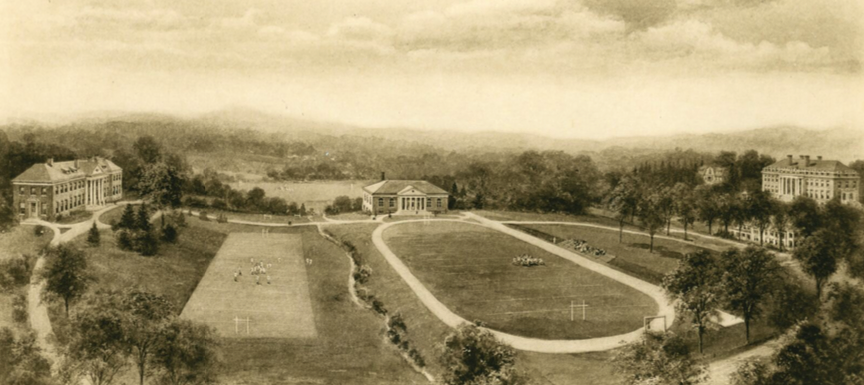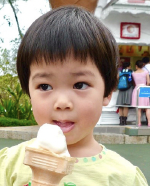
This engraving depicts the original plan for the placement of Memorial House, a mirror reflection of Hill House. It hangs on Dr. Curtis’s office wall.
Every room tells a story about its occupant, and Headmaster Dr. Alex Curtis’s office is no exception. Tucked away on the first floor of Archbold, his office may single-handedly offer more resources on ancient architecture than the entire Paul Mellon Arts Center, yet despite the limited space it still manages to represent the spectrum of his passions.
While a single step into the office reveals the cozy elegance of the room, the more intricate details that reflect Dr. Curtis’s interests are only exposed through close observation. The artwork on the walls, the literature on the shelves, the awards on the windowsills — those are the storytellers, the objects that constitute the core of Dr. Curtis’s office.
Perhaps the most prominent pieces in the room are four engravings, two set in Italy and two that are Choate-related. (At Swarthmore College, Dr. Curtis majored in ancient history and minored in Latin and Art History; he holds a Ph.D. in architectural history from Princeton University.) While the pieces look like detailed sketches, they are actually printed from metal engravings (a single engraving can produce many prints, each considered originals).
One engraving depicts Choate’s soon-to-be-constructed auditorium as though it were a ruin a thousand years in the future. At the bottom, there is an Italian inscription that translates to “Rome’s very ruins teach us.” To Dr. Curtis, this aphorism serves as a reminder “that even the greatest place is transient. Legacy is important — I mean, the buildings in these engravings have survived fifteen hundred years. But things will continue. Nothing is forever.”
Another engraving depicts George St. John’s architectural plan to build Memorial House on the hill where the track currently sits. “Hill and Memorial are the same building, so the idea was that they would be mirrors of each other,” said Dr. Curtis. However, George St. John walked his dog from peak to peak and used a stopwatch to time himself. Realizing the trek consumed over ten minutes, he chose to confine the building to a closer area.
By that time, the idea to design Hill and Memorial facing each other had been steadfastly established. “They had gone as far as to make this engraving to show people they were going to do it, and they were fundraising for it. It wasn’t just a whim,” noted Dr. Curtis.
And cancelling the design was no simple business. For the new plan (the design we have on campus today) to work, houses like Squire Stanley had to be uprooted from their former locations along Christian Street and physically moved to alternate locations. Dr. Curtis explained, “George St. John — who was responsible for all the great Georgian buildings on campus — realized he was wrong. He was strong enough to change his mind when he was wrong.”
Aside from engravings, Dr. Curtis has shelves packed with books, categorized by genre. Most of his books are related to art history, but he has ample selections of soccer team Leeds United titles, as well as non-fiction works written by notable alumni and guest speakers. A Sherlock Holmes enthusiast, Dr. Curtis also keeps an annotated volume of the most famous fictional detective in his office bookshelf: “Reading it takes you ten times as long because every part of it has notes explaining the background or inconsistencies with other stories.”
Dr. Curtis’s most treasured book in his office is the Macmillan Encyclopedia of Architects, which he purchased as a graduate student. “This was before the days of Google. This was the book,” emphasized Dr. Curtis.
Other interests are displayed as well. On the windowsill stands a plaque Dr. Curtis was awarded for his contributions to Princeton’s Women’s Rugby Team, which won the national championship twice under his coaching. President George W. Bush sent Dr. Curtis a letter of congratulations, which hangs proudly on his office wall.
As Headmaster, Dr. Curtis has naturally met with many important guests. According to Dr. Curtis, one of the most remarkable individuals he has had the honor to welcome into his office is Brad Snyder, a blind Paralympian who visited Choate in the winter of 2014. His favorite office visitors, however, are his own students here at Choate. “I’m very proud of our students. Last spring, a group of students came in to talk about divestment, and I remember that more than most famous persons,” said Dr. Curtis.
As saturated with his hobbies and passions as his office is, what ultimately matters most to Dr. Curtis is setting an example of inclusion for the Choate community, hence the rectangular discussion table that sits at the heart of his office. “I hope very much that I am a collaborative leader,” Dr. Curtis said, “It’s very important to me that I have a space that we can gather people regularly to talk and hear and listen to each other, and I hope that that goes on throughout the school.”



